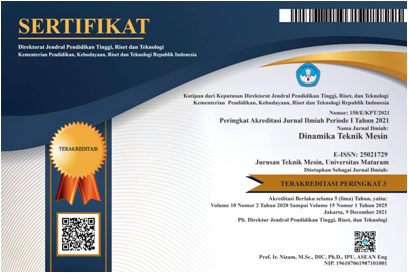Influence of infill parameters on the tensile strength of ABS 3D printing filament
Abstract
Keywords
Full Text:
PDFReferences
Alvarez, K., Lagos, R.F.,Aizpun, M., Investigating the influence of infill percentage on the mechanical properties of fused deposition modelled ABS parts, Ingenieria e Investigacion, 36(3), 110, 2016.
Dhinesh, S.K., Prakash,A.S., Kumar,S.K.L., Megalingam, A., Study on flexural and tensile behavior of PLA, ABS and PLA-ABS materials, Mater. Today Proc., 45, 1175–1180, 2021.
Grant, A., Regez, B., Kocak, S., Huber, J.D., Mooers, A., Anisotropic properties of 3-D printed poly lactic acid (PLA) and acrylonitrile butadiene styrene (ABS) plastics, Results Mater., 12, 100227, 2021.
Lubis, S., Djamil, S., Yolanda, Y.,The influence of object orientation in the 3D printing process for PLA and ABSpolymer materials on tensile strength and product dimensional accuracysuy, Sinergi, 20(1),27, 2016.
Mazlan, M.A., Mustar, M.F., Abdullah, A.H., Zakaria, N.A.C., Hashim, N.M., Pangesty, A.I., Effects of printing parameters on the mechanical strength of thermoplastics 3D printed specimens, J. Mech. Eng., 12, 101–117, 2023.
Muslimin, Farhan, M., Muhammad, A.M., Characteristics of mechanical properties in 3D printing result for motorcycle controller cover fabrication, Journal Mekanika Terapan, 5(3), 168-175, 2024.
Pernet, B., Nagel, J.K., Zhang, H., Compressive strength assessment of 3D printing infill patterns, Procedia CIRP, 105, 682–687, 2022.
Pranata, Y., Hasdiansah, H., Arriyani, Y.F., Tensile strength testing of ABS material 3D printing products, Prosiding Seminar Nasional Inovasi Teknologi Terapan, 3(1), 2022
Raffik, R., Sivaguru, J., Parveen,S.A., Sabitha, B., Naveen, C., Murugajothi, T., Experimental investigation on stereolithography process parameter optimization and its influence on smooth surface finish for ABS accura-60 material, Mater. Today Proc., 2024.
Singh, S., Rajeshkannan, A., Feroz, S., Jeevanantham, A.K., Effect of normalizing on the tensile strength, shrinkage and surface roughness of PLA plastic,Mater. Today Proc., 24, 1174–1182, 2020.
Widyanto, S.A., Development of rapid prototyping technology for manufacturing multi material products, Rotasi, 9(4), 10–14, 2007.
DOI: https://doi.org/10.29303/dtm.v15i1.949
Refbacks
- There are currently no refbacks.
Copyright (c) 2025 Open access

This work is licensed under a Creative Commons Attribution-NonCommercial 4.0 International License.






















